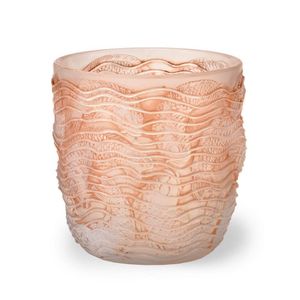Rene Lalique Dauphins Vase
You must be a subscriber, and be logged in to view price and dealer details.
Subscribe Now to view actual auction price for this item
When you subscribe, you have the option of setting the currency in which to display prices to $Au, $US, $NZ or Stg.
- Acid Etched - Acid etching is often used on glass, metals, and stone to create decorative finishes or to prepare the surface for further treatment or coating. The process of acid etching involves applying an acidic solution, such as hydrochloric acid or nitric acid, to the surface of the material and allowing it to react with the surface. The acid etches away a thin layer of the material, creating a rough, uneven finish. Acid etching can be used to create a variety of different finishes, from a subtle matte finish to a more pronounced, textured finish.
- Opalescent / Opaline - The descriptions of glass as "opalescent" or "opaline" are often used interchangeably by dealers and auction houses. At the upper end of the scale, opalescent / opaline glass can refer to the opal-like milky blue glass produced by Lalique and Etling. It also refers to the pressed glass mass produced in Britain from the 1840s with a milky white edge as sugar-basins, milk jugs and vases were made in great quantities for the mass market, and were sold at fairs along with Staffordshire figures and wooden dolls. A less common type of opalescent glass was made from two layers of glass blown into a mould.
- Patination / Patina - In broad terms, patination refers to the exterior surface appearance of the timber, the effect of fading caused by exposure to sunlight and air over the course of a century or more, changing the piece to a soft, mellow colour.
As patina is very difficult to replicate, it is one of the most important guides to determining the age of furniture.
Patina is also the term applied to the bloom or film found on old bronzes due to oxidisation. - Etched - Glass decorated with an etched design, which is achieved through marking out the pattern, protecting the area that is not be etched, and then immersing the object in acid to dissolve the surface of the unprotected area. With some glass objects, such as cameo glass, there may be several layers of different coloured glass, and part of the top layer is dissolved leaving the bottom layer as the background. The longer the time of exposure of the object to acid, the deeper the etching.
The word etching is also sometimes used to describe another method of decoration, where wheel grinders were used decorate the surface, but this technique is usually known as engraving.
This item has been included into following indexes:
Visually similar items

A Rene Lalique Dauphins vase, designed 1932, the sides with golden brown staining and fluorescent dolphins amongst rippling waves, signed R. Lalique, France', 13.8 cm high, Literature, Felix Marcilhac, R. Lalique, Catalogue Raisonne De L'Oeuvre de Verre, E

Rene Lalique Laurier vase clear. Frosted & opalescent, the cylindrical form vase rising to a slightly everted rim, the body moulded with leaves & berries, design number 947. Signed R Lalique'. Condition fair, chip to the base. Height 17.5 cm

An small Chinese ivory carved brush pot, 20th century. 9.5 cm high

A Rene Lalique Raisins vase, designed 1928, the tapering cylindrical body moulded with grapes and vines, in frosted and opalescent glass, acid etched R. Lalique France, 15.5 cm high. Provenance: Mr Hans Mueller and Mrs Gertrud Mueller, Sydney. Literature:
